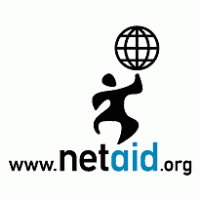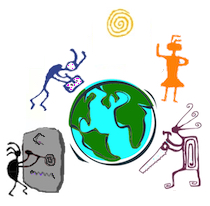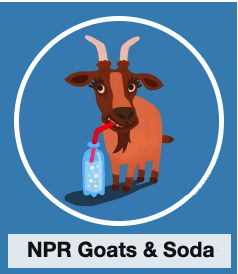
October 9th is the 20th anniversary of the NetAid concerts, which launched a web site allowing people to volunteer online to help NGOs & United Nations initiatives all over the world – a web site that still exists and has mobilized many thousands of online volunteers to contribute to what we now call the Sustainable Development Goals.
NetAid started as a joint venture between the United Nations Development Programme and Cisco Systems, and launched with a concert event on October 9, 1999 with simultaneous activities meant to mobilize online volunteers and raise money and awareness for the Jubilee 2000 campaign – in the spirit of BandAid and LiveAid. The NetAid concerts took place at Wembley Stadium in London, England, Giants Stadium in New Jersey, USA, and the Palais des Nations in Geneva, Switzerland. Performers at the concerts included some of the biggest names of the day: Eurythmics, Bryan Adams, George Michael, David Bowie, Robbie Williams, Sheryl Crow, Jimmy Page, Busta Rhymes, Counting Crows, Bono, The Black Crowes, Sean John Combs (then Puff Daddy), Jewel, Mary J. Blige, Sting, Lil’ Kim, Ladysmith Black Mambazo and many more. Cisco sponsored the concerts and the web site, originally www.netaid.org. UN Secretary-General Kofi Annan was an enthusiastic supporter of the initiative.
In an October 7, 1999 New York Times article, Djibril Diallo, then UNDP public affairs director, said ”We want to use the computer to help change how the world looks at poverty and motivate people to help.” He said UNDP began examining ways of combining music, high technology and altruism more than a year before the NetAid concerts. The article notes that the NetAid web site was meant to be “a clearing house of information on the state of world poverty and the agency’s programs as well as a means of raising money.” The article quotes Mark Malloch Brown, then head of UNDP, who said ”The difference between this and earlier concerts is that we created a vehicle for people to come back, not just on the night of the concert with the one check they write. But instead, here’s a site they’re going to come back to time after time.” The article also noted that the web site “will permit groups and people with particular needs to register them in a Netaid database. It will also allow people who are willing to donate particular skills or materials to register them in the database.” After the concerts, in a Washington Post story, “NetAid Catches Few On the Web,” Robert Piper, described as manager of the NetAid site for UNDP, said the main purpose of NetAid was to mobilize volunteers, not money. “We’ve been [complaining] for years about the need for people in the developed world to participate [in aid programs], but they never had the tools to participate,” said Piper. “With the Internet, people can now get emotionally and intellectually involved.“
I am asked frequently how I started working for the United Nations. The answer: NetAid. Specifically, to fix the NetAid website and process regarding virtual volunteering. A lot of effort was put into promoting NetAid and recruiting online volunteers – but very little effort was made to teach UN agencies and NGOs how to create assignments for online volunteers and how to support those online volunteers in assignments. Therefore, NetAid floundered. UN Volunteers, an initiative of UNDP, was in charge of the virtual volunteering part of NetAid, and someone at UNV found some of my messages on an online discussion group for managers of volunteers. At the time, I was directing the Virtual Volunteering Project at the University of Texas, and I just happened to be the only expert on the subject of virtual volunteering (thankfully, I’m not all alone anymore!). That UN employee shared my information with others at UNV HQ, and I was recruited, specifically, to work at UNV/UNDP on both NetAid and the UNITeS initiative. And the rest, as they say, is history…
By 2002, the online volunteering part of NetAid had been moved entirely to www.onlinevolunteering.org (like that URL? I’m the one that chose it!) and was entirely owned and managed by UNDP/UNV. And it still is!
Meanwhile, NetAid, which had become a nonprofit based in New York City, tried to find a path forward. It explored the use of videogames for social change, co-founding the Games for Change movement in 2004. In 2004, NetAid co-produced a game with Cisco Systems called “Peter Packet,” which addressed how the Internet can help fight poverty, focusing on issues of basic education, clean drinking water, and HIV-AIDS. By 2006, NetAid had a new focus: to raise awareness among high school students in the USA regarding poverty in developing countries. The different campaigns of NetAid are chronicled through archived versions of its web site, www.netaid.org, available at Wayback Machine. In 2007, NetAid became a part of Mercy Corps and was quickly disbanded.

The onlinevolunteering.org site continues to bring together online volunteers and NGOs, UN agencies to do good things. And the lessons from NetAid regarding virtual volunteering can still be helpful to any tech4good, micro-volunteering initiative starting now. In fact, lessons from NetAid, and many other organizations engaged in virtual volunteering, informed the recommendations offered in The Last Virtual Volunteering Guidebook, available for purchase in paperback directly from me or as an ebook (PDF) by the publisher, Energize, Inc.









